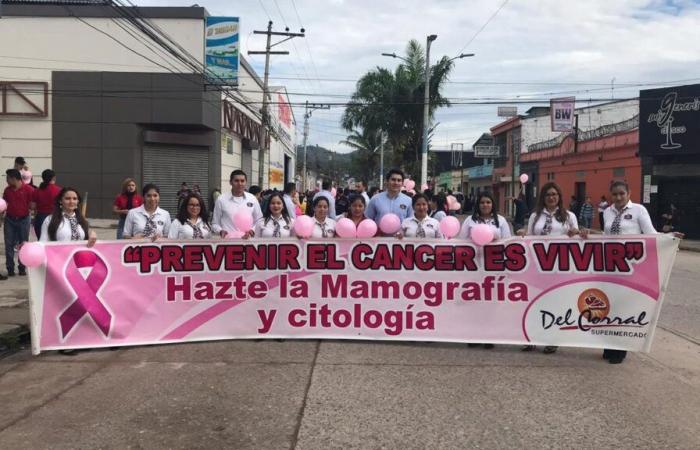International Breast Cancer Awareness Day was celebrated on Wednesday, October 19, 2024. Despite the stupendous discoveries in the medical field, breast cancer accounts for 16% of all cancers among women, according to WHO data. Faced with this prevalence which seems to have been increasing for years, “early detection campaigns are highly encouraged in order to effectively deal with this scourge,” believes obstetrician-gynecologist Tendobi Mbamba Céline.
Interview conducted by Christian Losambe, SJ – Vatican City
Organized every October, the annual global campaign “Pink October» is intended to raise awareness among women about breast cancer screening and to raise funds for research. Today, breast cancer remains one of the major health concerns, and is both the most common and the deadliest among women. The WHO estimates that one in eight women will suffer from this disease during their lifetime, which is why women should undergo regular screening.
As part of the celebration of International Breast Cancer Awareness Day, during an interview with Radio Vatican–Vatican News, obstetrician-gynecologist Tendobi Mbamba Céline, from the Monkole Hospital Center in Kinshasa, DR Congo, emphasized that “It is possible to reduce the prevalence of breast cancer by implementing sound strategies for prevention, screening, early detection and treatment“. Here is the entire interview.
Follow Doctor Tendobi Mbama Céline, gynecologist-obstetrician at the Monkole Hospital Center in Kinshasa, DR Congo.
What could be the basis of the increasing prevalence of cases of women suffering from breast cancer, while every year an awareness campaign is organized?
Indeed, we have noticed that there are more and more young women who come with breast cancer problems. In the past, we had patients who presented with breast cancer at a fairly advanced age, but now we have young ladies under 40 suffering from it. I think we have to look at the reasons in terms of risk factors. We have noticed that the lifestyle has changed a lot: we have become more and more sedentary with excess weight, which means that there are more and more cases of breast cancer among young women. Among the etiologies, there are also genetic mutations. There are, in fact, 10 to 30% of women who undergo genetic mutations, BRCA1 and BRCA2 mutations, which are the cause of breast cancer.
Furthermore, there are hormonal factors, including early puberty, late menopause, multiparity and a late first pregnancy. It is also in this group of hormonal factors that we find a very high number of women suffering from breast cancer.
Why does breast cancer still threaten health despite advances in science and prodigious discoveries in the medical field?
When we organize breast cancer screening campaigns, we would expect healthy women, or presumed healthy women, to come for consultation. Unfortunately, we notice that it is mainly women with already advanced cancers who present. So, I think the problem lies on the information side. However, when the disease is already very advanced, we can treat it but we are not sure of curing it. On the other hand, when a woman comes early, she has a much greater chance of being cured. Even if she considers herself healthy, she comes for screening, suspicious lesions are noted, the assessment is established and when we realize that she is ill, she is treated in time. There is also biological complexity and other environmental factors that could account for this increasing prevalence of cases in women with breast cancer.
The WHO estimates that one in eight women will develop breast cancer during their lifetime. Do you also educate women on how they themselves can detect the onset of breast cancer early to avoid discovering it late?
Yes, indeed! However, one thing should be pointed out: in young girls or young ladies, the breasts are much denser. There is a lot of water and therefore it is difficult to make cancer diagnoses at the initial stage. As age advances, it is much easier, especially with mammography, which is indicated in women over 40, where the breasts are less dense and the lesions are much more visualized. But the most important thing is awareness of self-examination.
The woman, once a month or every two to three months, should feel her breasts to look for any lumps. When she notices an abnormal situation, she must consult a doctor to present what she has noticed. And it is the doctor who will tell him, after the clinical examination, whether it is normal or not. And if he needs explorations, for example an ultrasound or a mammogram, he will do it to confirm the lesion or say that it is not a suspicious lesion.
October 19, 2024, another day to talk more about breast cancer awareness. What would be your last words and what message could you send to all these women who are fighting this disease?
I would point out, first of all, that breast cancer does exist and is deadly. If you don’t get proper treatment, you can die because breast cancer kills. The opportunity we must seize is to detect the pathology in time to increase the chances of survival. I would then invite all people to become aware of the importance of early detection.
Regarding people suffering from breast cancer, I show them all my compassion and all my sympathy. They must fight, stand firm and know that their resilience inspires many people. They are not alone. I also encourage all the people who are involved in their field to save many lives. We are counting on them, on their courage, on their bravery so that they continue to fight to find adequate molecules to continue to treat women suffering from this disease.









